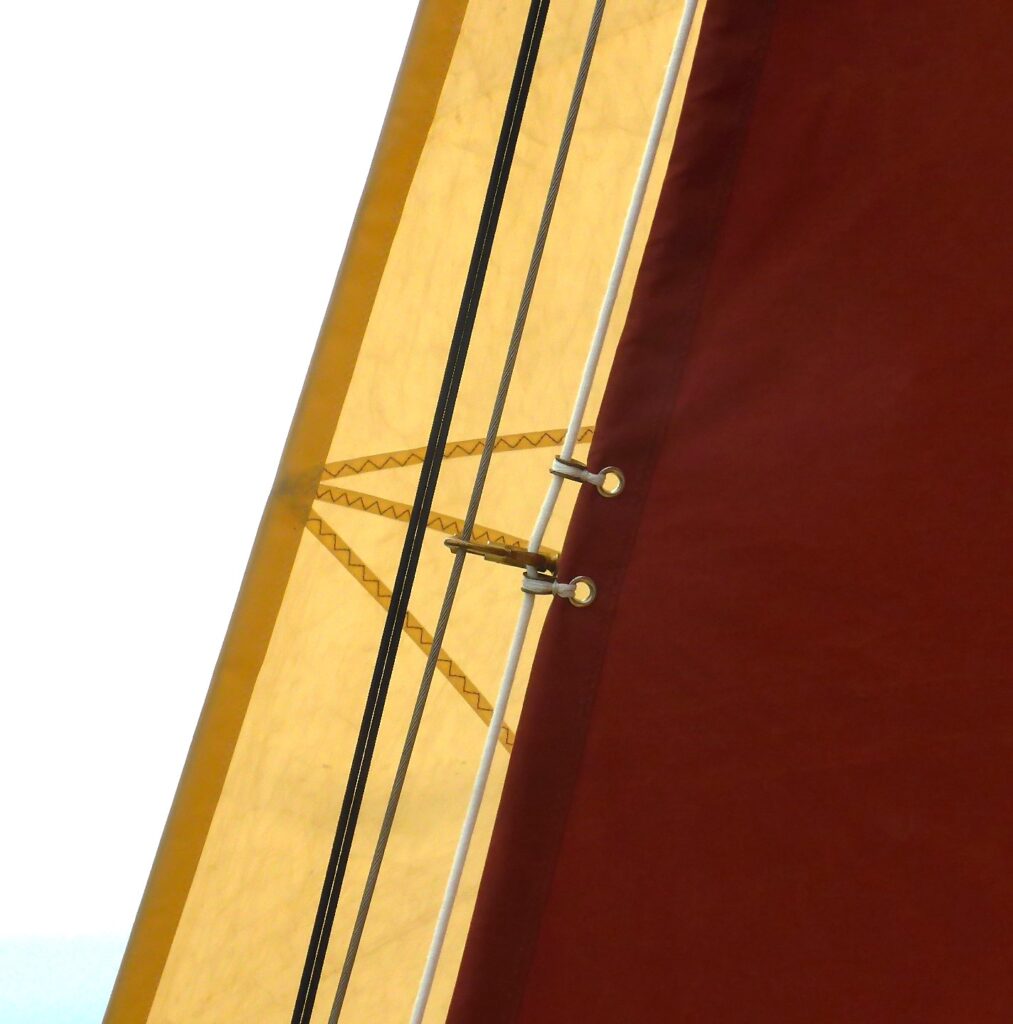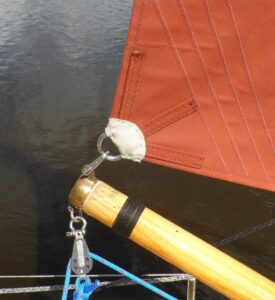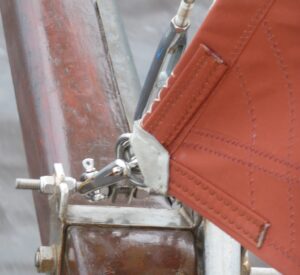
Close-hauled gaff cutter rig. Both the foresail and the mainsail have booms, although the latter is barely visible on the edge of this image. The foresail boom is sheeted via a horse athwart the foredeck.
If you are looking for a new bespoke sail, please allow me to recommend Jeckells of Wroxham. We ordered a new (boomed) hanked-on foresail for our gaff-cutter-rigged Finesse 24, made in Clipper canvas to complement the mainsail (which was made 10 years ago by Steve Hall). Clipper is a cruising cloth, made by Richard Hayward & Co. in Tiverton, Devon, which feels soft and looks traditional. Jeckells will make sails using this material, but when I made my initial enquiry I wondered if their quotation would be affordable. After all, this foresail would also have an unusual

Detail of the jack-line (white), parallel to the forestay
feature: a jack-line, which makes it possible for a boomed triangular sail to be lowered completely without being detached from the forestay. The lower hanks are threaded onto the line, rather than being clipped to the sail luff, and this line collapses as the sail is lowered.
Well, affordable, it was! Taking along an old and played-out foresail that we had used for a couple of years, we spent a pleasant Saturday morning in Wroxham discussing our requirements. The old foresail had leathered, external rings rather than grommets- could they do that? Yes, they could.

External clew ring, leathered
Would I like the old stencilled logo at the tack rather than the modern sewn patches? Yes, I would. Can I have some tell-tales? Thank you very much!
The total cost of these extra bits and bobs, over and above their original estimate, was precisely zero. They made the sail using our old sail as a pattern, with a few more inches at the head, and delivered the sail by post for £20 + VAT. The cost for the build was £410.55 + VAT, a remarkable price from a long-established firm offering personal service.
Using a boomed foresail in a cutter rig

External clew ring, leathered. The angle of the shackle (equivalent to the sheeting angle) should be aiming about 40% of the way up the luff. This, and the depth of the sail, are affected by the position of the tack up the forestay.
Tom Cunliffe’s advice for setting up a cutter rig for sailing close-hauled is, paraphrasing: (1) Sheet in the foresail as hard as you can, (2) let the mainsail out until it is very slightly backwinded, and then (3) set the jib so it is neither stalled nor luffing (in practice, the jib is more-or-less hidden in front of the foresail, so we let the jib-sheet out until the jib rattles and then bring it back in a bit). The problem here for a boomed foresail is that, when its clew is hauled down, the angle of the applied force is built in to the geometry of the sail attachments; the clew cannot be simply hauled harder aft.
The depth of a boomed foresail (pivoting on the Sampson post) reduces as its boom is sheeted in. Close-hauled, the boom can be sheeted hardest in when the jib is also set, as the jib will help to direct air behind the foresail to alleviate stalling, so the sail depth in this configuration is probably the most critical initial adjustment. At the same time, the sheeting angle needs to be optimum. However, a boomed foresail isn’t sheeted in the conventional sense, so the angle of the shackle that attaches the clew to the boom is your guide to the correct balance of forces on the foot and leech of the sail.

The overall length of the shackle(s) at the sail tack is your main adjustment.
Both the depth and the shackle angle are affected by changing the length of the shackle(s) attaching the tack to the boat stem- and just a few inches will make a noticeable difference. You make this choice once, and hope that it works pretty well for other angles of sailing. If the foot of the sail is too short or too long for a satisfactory adjustment, then you may be making a new boom! When ordering a new foresail, it is critical to specify the length of the foot so that the sail will set a shallow curve between the tack and the clew when the boom is sheeted hard in.
69 sq ft cross-cut foresail in Clipper cloth, by Jeckells of Wroxham, £410.55 + postage and VAT.


